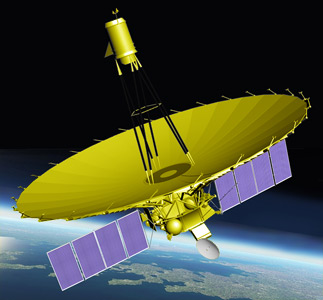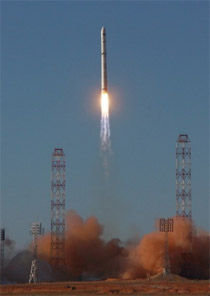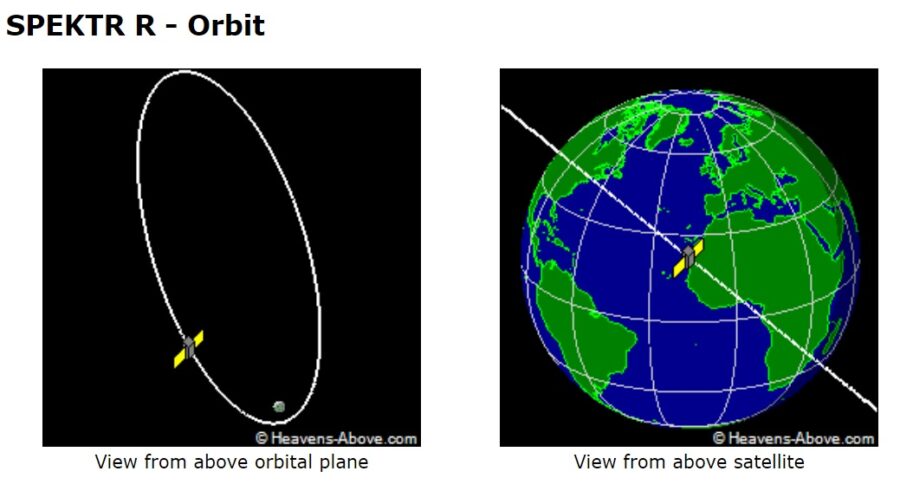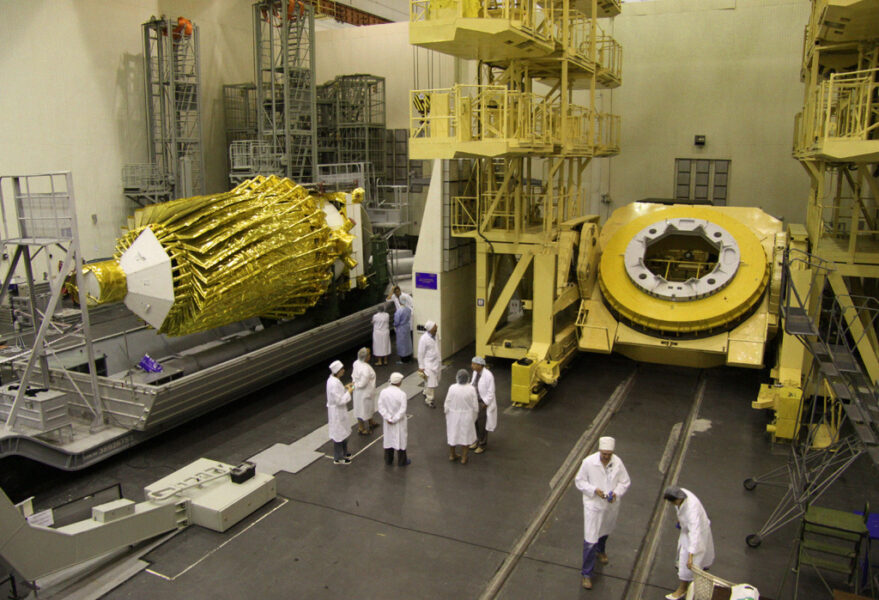The spent Fregat Stage that deployed the Russian Spektr-R radio observatory a decade ago is now set to re-enter, burning up over the Indian Ocean on Monday, August 9th.
Update: Space-Track confirms that the Fregat stage that launched Spektr-R did indeed reenter yesterday on August 9th at 16:24 Universal Time (UT) +/-1 minute over longitude 87 degrees east, latitude -49 degrees south under nighttime skies, over a remote stretch of the southern Indian Ocean.

RadioAstron
A key stage of a now defunct astronomical observatory is set to burn up in Earth’s atmosphere on Monday, August 9th.
The object in question is the 1.5-ton Fregat-SB upper stage booster, which deployed the Spektr-R radio observatory in an elliptical orbit for Russia’s RadioAstron program in 2011. The rocket booster is set to reenter near perigee over the Southern Indian Ocean under nighttime skies on Monday, August 9th, around 16:26 UT/12:26 p.m. EDT, per the U.S. Combined Space Operations Center Space-Track.

Yuzhny Space Center
Sounding like something out of a James Bond film, the Spektr-R mission launched on July 18, 2011, atop a Zenith-3F rocket from the Baikonur Cosmodrome. Employing a 10-meter radio dish that unfurled once the observatory was in orbit, Spektr-R observed radio sources within and outside our galaxy, carrying out long-baseline interferometry in concert with Earth-based radio telescopes.
The satellite worked from an orbit inclined 42.5° relative to the equator, ranging from a close perigee of 10,652 kilometers to a distant apogee of 338, 542 kilometers, ranging nearly the distance from Earth to the Moon. The observatory lasted well beyond its planned five-year mission but stopped responding on January 11, 2019.

“Spektr-R is easily observable in a highly eccentric orbit, tumbling,” says satellite tracker Goran Gašparović. “Its magnitude varies considerably depending on the radio dish orientation.” The telescope can still be seen flashing and tumbling on close perigee passes during its 8.8-day orbit. Find close passes using the Heaven-Above satellite database, where Spektr-R is listed as object ID 37755.
Russian missions have used the Fregat stage since early 2000, for 91 launches to date. The stage is made up of spherical fuel tanks in a ring configuration. Though mostly successful, the stage has had failures in the past: Its faulty main propulsion unit doomed the Phobos-Grunt mission to the eponymous Martian moon in 2012. The mission reentered Earth’s atmosphere still attached to its booster stage. The Spektr-R Fregat stage itself experienced an explosive anomaly on May 8, 2020, adding over 65 new debris objects in orbit.
The #Fregat Upper Stage consists of 6 spherical tanks, 4 for oxidizer and propellant and 2 tanks accommodate equipment. The tanks are arrayed in a circle, with trusses passing through them providing structural support. #GKRocketSchool pic.twitter.com/mteLCj3sy6
— GK Launch Services (@gk_launch) January 30, 2020
This event highlights the spate of high-profile reentries we’ve seen in recent years, with more to come. These include the reentry of the 1960s OGO 1 observatory on August 29, 2020, the reentry of the errant Long March stage that deployed the Tianhe module for China’s new space station, and the increasing number of Starlink satellites reentering in 2021, all attrition from SpaceX’s massive new mega-constellation of communication satellites.
Solar activity can play a role in accelerating reentries, puffing up Earth’s upper atmosphere and increasing atmospheric drag on satellites. The current solar cycle 25 seems to be ramping up faster than anticipated in 2021, meaning more reentries to come. However, Gašparović notes, “the reentry will be at a steeper angle than OGO 1, thus we will not see the large orbit perturbations by the atmospheric drag at the last few perigees.”

RIA Novosti archive, image #930415 / Oleg Urusov / CC-BY-SA 3.0
When will Spektr-R itself come down? With a higher perigee, the now inoperative radio observatory is in a much more stable orbit than the booster that placed it there; it probably won’t reenter for centuries to come.
We’ll note here when the Fregat stage comes down on August 9th, and if, in fact, the reentry is actually spotted.
 2
2
Comments
Yaron Sheffer
August 7, 2021 at 6:57 am
Too bad there's only one coming down... Not because of the booster, but because a fleet of 10 (or more!) Spektr-R telescopes would have been a truly amazing and wondetful array for interferometrical purposes...
You must be logged in to post a comment.
Andrew James
August 8, 2021 at 2:31 am
Why do you northerners keep dumping your space garbage in our pristine southern oceans? Russia and China dumps everything in the Indian Ocean while the Americans think its perfectly okay to do so in the southern Pacific Ocean. Duck and cover is suppose to apply to nuclear weapons not your space junk! Really.
You must be logged in to post a comment.
You must be logged in to post a comment.